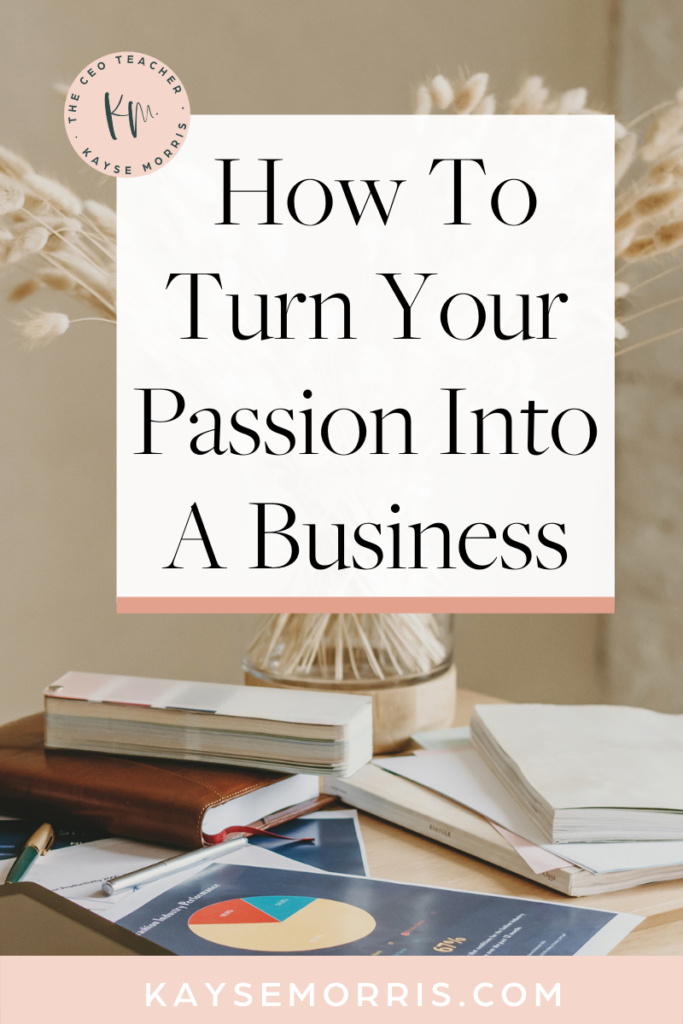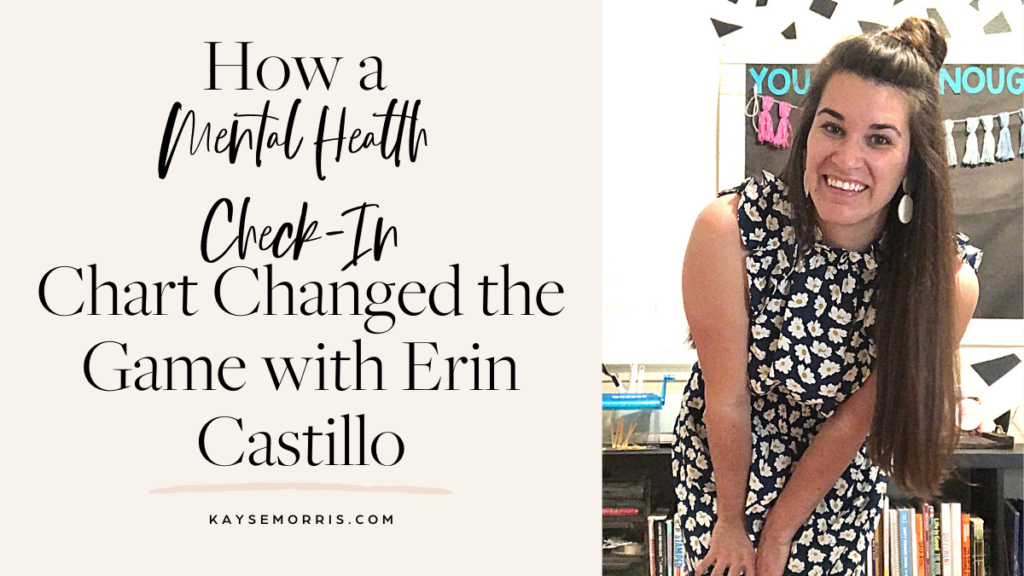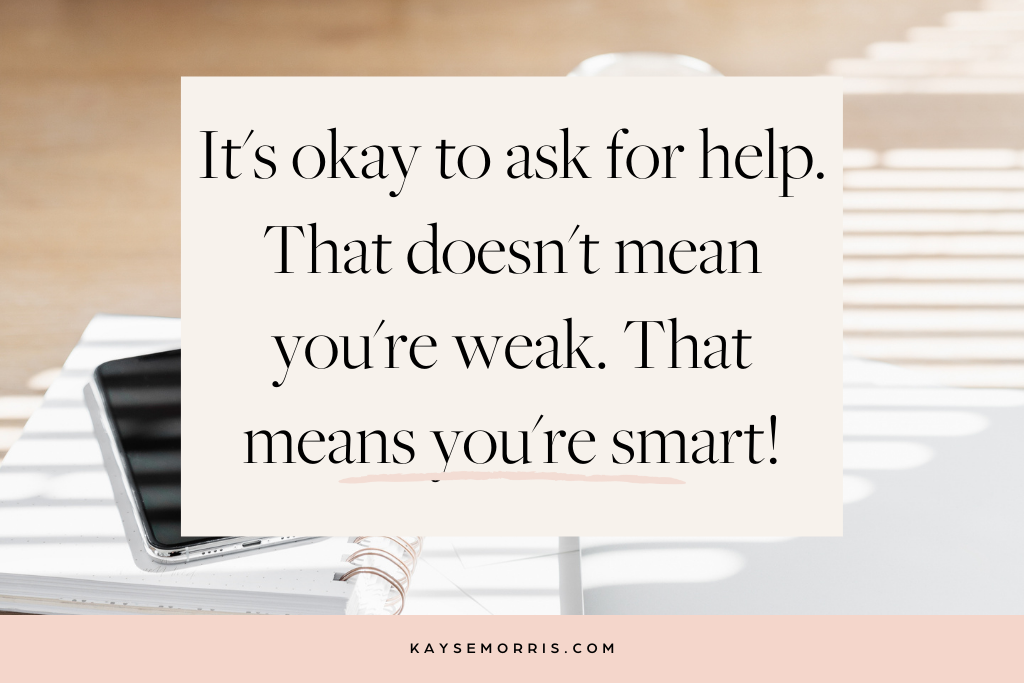How a Mental Health Check-In Chart Changed the Game with Erin Castillo
A mental health check in for students and teachers changed the game in and out of the classroom with this week's guest. I had the privilege of meeting Erin a few years back at a teacher conference. It was kind of a full-circle moment to be able to interview her and chat about mental health for teachers and students. She was a student in one of my presentations at a TPT conference, and we hit it off instantly and I am so thrilled to share with you how she made her passion her job. It's just the coolest thing ever.
Erin Castillo is a special education teacher by day. And a mom by late in the day and night. She teaches high school mild to moderate, which a lot of people kind of get confused about. She is mostly teaching English for students that have learning disabilities that need just a little extra support and accommodations in the classroom. And then along with that, she also teaches an amazing class and runs a program called Pure Resources. And it's where she trains students to be peer counselors. They assist with restorative conferences. Providing mental health check-in support and resources for students by students. It's a more comfy situation than going to an adult sometimes.
When I reached out to Erin I knew we really wanted to talk about mental health, and how she’s used that to create her business. But most importantly we were able to talk about mental health for teachers. I just recently interviewed Stephanie and Lorielle from Happily Ever Elementary. And we didn't intend for our conversation to go there, but as moms and as teachers it undoubtedly did. And I'm really glad that it did because we got to have a really vulnerable conversation about our mental health.
So Erin and I chatted about mental health when it comes to being a teacher and her journey through learning more about herself so that she could help other people. Erin went into education going 120mph and she and her vehicle got tired real quick and started to feel that burnout. She saw all the other young teachers around her on social media that were going in early and staying late and coming home and doing more. And she started to feel inadequate like she wasn't doing enough.
And at that point, she realized with how many teachers leave the profession, that it's not sustainable to work or live that way. And that there's a difference between being passionate and taking care of yourself and being passionate and overworking yourself. So she really took a step back and started thinking about what she needed and how she could provide it to other educators and share it with them so that they're not feeling so alone. Or they're not feeling like they're not good enough if they're unable to work so many hours every day.
I 100% agree with everything she said and wondered why teachers put themselves in that situation? Erin agreed, especially in the beginning, teachers feel like it's kind of a Rite of Passage. The majority of teachers are really giving and live to serve and to help students and help others. That passion and desire to prove themselves and to show that even though you might be a young teacher you know what you are doing. Asking for help or showing that you’re struggling, says to the world that you’re not supposed to be in this job.
It’s important for teachers to show they need more help than what they’re letting on. It's okay to ask for help. And that doesn't mean you're weak. That means you're smart. You're getting more support. You're getting more ideas. You're only going to end up being a better teacher. And I think it's really important to note here, how self-aware you are is a direct correlation to this idea. Saying to yourself, wow, I'm doing too much and I need to reassess and see if this is maintainable for my mental health. And I think finding that balance between it's okay to want to do everything. You can still be that girl (or guy). But also know that you have to ask yourself at what cost.
Erin remembers in her fourth year of teaching, she had a really difficult year. She had a really toxic coworker that was pulling her down. She had a difficult situation with students and a family that could have possibly gone legal. It was getting too uncomfortable. And at that time she realized she was pouring so much into all of these different avenues and losing herself in the process. That was the year that she made a decision to choose HER.
Turning A Daily Mental Health Check In into a Business
Erin started discussing mental health on Instagram and turned that into a business that has legitimately exploded. Originally she was sharing mostly in IG stories. She had occasional posts with little gems or pearls or whatever we want to call it. And wondered how to make it something that people could take with them. More of a resource of sorts. So she started making more informational posts that could be saved. She began making those into worksheets for different topics that teachers could download and save. And it's all just grown from there.
Erin’s mental health check in sheets (that is what she calls them) are for anyone and everyone. She utilizes them quite often. She tends to model them on difficult days so she can show her students, Hey, I'm a human and it's a rough day today. And then she invites them to check in with her. They're great to put in the staff room and staff can check in or at the start of a staff meeting or a department meeting. And Erin has heard from people that have used them in their church groups. And others that have them in their homes with their children.
It is a way to communicate if you are feeling like you’re in a dark place and need some help. These mental health check-in sheets start off very private. In a corner of the room where students can't see each other go up to it. And after talking about it in the classroom the students get more comfortable using it. Erin recommends just speaking out loud, telling the students, “I'm having a rough day today.” Over time the vibe will shift from a safe space to a brave space. Where students and teachers share their feelings and emotions and when they need help. When you are brave enough to do that, it allows for others to feel brave and to step up.
So how does Erin deal with the students that maybe think the mental health check in is silly? Or those that would never ever put their name on there to say that they need help because they feel a little too proud. With those students, she says it may take more modeling and authentic connections, but over time it starts to happen. She never envisioned that the charts would catch a hundred percent of students where they're at. But she felt that it could catch more than what she is able to catch with the naked eye, she was headed in the right direction. You can't always tell if students are struggling, because they're really good at masking.

And so that's something that Erin points out when you begin using the mental health check in. It's going to take time for some, but if you keep at it and you keep it authentic and you continue to share, people will get there. Erin is such a testament to keeping the main thing, the main thing. I feel like every time I see something with her name in there, it's always back to the mental health side. Even when she is just making a statement and making sure that you're taking care of your kids.
Turning an Idea into a Business
Erin didn't want to charge people for the mental health chart because it's something that she just feels every student should have access to if they need it. So it's free on her page. She doesn't charge anything for it. It's translated into like 18 languages. And there are a couple of different versions with different wording for younger kids. And she has made the business decision that the original document will always be free. Then she went on to create other resources so that people saw the level of the work and heard from her on social media and saw her passion. Heard her share about things and other resources that can be purchased for students. And then that turned into a lot of working with companies that support mental health, with sponsorships and collaborations. She really encompassed the 80/20 rule that we encourage in our programs. But as far as the actual chart itself, Erin gets asked all the time, why didn’t she charge for it? And she just can't, she just feels like it's something that people need.
And I think that's important in running a business that people see that aspect. That's part of being genuine and authentic. Sometimes the best product you create is going to be free, but it's going to lead people to look at other things that you've created and see you as someone that's trustworthy. That in turn will help people be willing to purchase and pay for your time in other ways. I think sometimes we worry, oh, well, we're giving it all away for free. That's a really common question we get on our coaching calls, how do I know what to charge for? Am I giving away too much of it for free? And I think Erin’s answer was just a perfect example. She can't charge for her mental health chart because she wants students everywhere to have access to this, no matter what. Now her idea has turned into so much more because of that giving part. I think that whatever you put out into the world is what you get back.
The Turning Point from Mental Health Check In Chart Creator to Mental Health Advocate
Insider reached out to Erin. And it wasn't even in her email, they slid into her DMs. Kind of like, “So you made this chart, we want to interview you.” And Erin thought it was a joke, because it happened to be on April Fool’s Day. And then every day for months, she had multiple emails or DMs asking her to do interviews, be on TV shows to fly out to a conference. So she flew to New York and spoke at a safety conference for Facebook. She was everywhere. It was pretty intense for a while there, she was everywhere. You couldn’t do a Google search for mental health without seeing her face pop up. It was really cool because as she started hearing from people around the world she was able to translate her origins document into so many different languages. That was the most incredible feeling ever for Erin to know that her FREE mental health check in is being used everywhere. That it's a universal measure for student wellbeing.
It all started on Instagram and then it went to Facebook and was shared by a suicide prevention page. And from there, it went mega-viral, 500,000 shares, something wild like that. Erin knows she doesn't utilize Facebook probably well enough, but Facebook has a ton of users who will share things. And because it stays on your page versus sharing an IG story, it gets a lot more eyes on it. Utilizing Facebook made it take off literally overnight, there wasn’t a huge strategy behind it. She shared what she was passionate about. It got taken to Facebook and then it went viral from there.
Sharing Your Message With The World
When she first started teaching, 9 years ago, she started a blog and stopped because, you know- life. And then she tried it again after all this happened. She kept telling herself, “I need a landing page, I need a website, and I need a plan.” And she wrote about 3 posts and stopped again. So these days she mostly uses Instagram as her blog, or sharing platform. That's where all her posts and information go. She does share a lot of it on Facebook. But Instagram is definitely her main platform. This is so good for people to hear. New CEO Teachers® can feel really overwhelmed when they think they have to do all the things. Write blog posts, and share on 5 different social media channels, etc. When they think they have to be on Facebook, on Instagram, on Pinterest, on YouTube, on Tik ToK. Now on Clubhouse and LinkedIn. So I am thankful for Erin sharing that you can be passionate about something. You can turn that into something for free, for the greater good of humanity and you don't have to be in all the places and on all the platforms for your idea to bring amazing opportunities.
Opportunities to Share about Mental Health
From Good Morning America to the Kelly Clarkson Show, and in between. Erin continues to share her mental health check in and how she utilizes it in the classroom. Kelly Clarkson loves education, she herself was almost a teacher. So she has a real passion for education and she definitely spotlighted Erin’s mental health check in chart really well. That was actually the first platform where Erin was able to share a bit about the inconsistencies with data. The inconsistencies in schools where they state they need so many psychologists for a specific number of students and so many counselors for a certain number of students. And what Erin is finding is the suggested amount is not met, and 80% or more of schools are not even coming close.
When she talked with Buzzfeed, they focused on the positive side of the chart, which I understand. But Erin also wanted people to see that the chart isn't the fix. We do have an issue within the education system. We do need more mental health providers and staff on campus. We need more resources for students and teachers. Kelly Clarkson was able to give Erin an opportunity to share about the need side. And that is still the most important aspect of Erin’s journey. The main thing is the main thing and that is the mental health of students and teachers.
I know everyone is going to want to follow Erin's journey, and maybe grab a mental health check in sheet for yourself. You can find her at Making a Statement in SPED on Instagram and Facebook. If you're really looking to get to know her and dive into the content and just chat with her, Instagram is the place to do that.
I know what a struggle it is to open up and say I am in a dark place. Please know that if you ever need a listening ear I am here to help. You can always reach me in the DMs, and we can chat. I also wanted to share a few more articles that may be helpful on your journey to mental health awareness.
Teachers Mental Health has Suffered
Leave a Reply Cancel reply
This site uses Akismet to reduce spam. Learn how your comment data is processed.
Behind-the-Scenes Secrets to TPT Success
This training will not only show you how to make the perfect TPT resource...
l'll also teach you how to make sure it ranks #1 in search (because getting found is how you get paid!) and the secret to rocking your resource marketing!
Seats are limited; sign up now!
3 Steps to Sell Your Resources Like Hotcakes on TPT and Beyond…
save me a spot!
FREE WEBINAR
In this training, I'll show you how to build an online membership in 90 days, so you can have consistent income (in addition to your teaching salary) all year long!




your comments